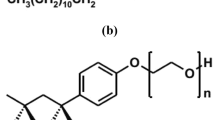Abstract
The influx of solid or liquid particles of drilling mud into the pores of rock or mud loss phenomenon and clay swelling can sometimes lead to severe productive formation damage and cause to wettability alterations of reservoir rock from hydrophilic to oleophilic. Therefore, designing an appropriate fluid that is compatible with formation fluids and could reduce reservoir damage and increase the productivity of wells is very important. The two main mechanisms of surfactants are reduction of the surface tension and wettability alteration of rock reservoir that are effective in taking the oil. Regarding the importance of the wettability in reservoir productivity, this article is aimed to study the effect of nonionic surfactants polyethylene glycol (PEG) in the presence of acrylamide hydrolysis (PHPA) in water-based drilling fluids. For the measurement of wettability alterations, measurements of contact angle as a quantitative method and measurement of clay swelling, weight difference was used. The calcium carbonate was used as a representative of the reservoir rock. The experiment was designed so that the parameters of drilling fluid (fluid loss control, rheology, chloride, potassium chloride, pH, temperature, PEG and PHPA volume percent) are close to the reservoir. In order to simulate reservoir conditions after contact of calcium carbonate with drilling fluid, we put the sample in cylinder containing drilling fluids, and for more simulation of reservoir conditions, the test was repeated at 80 °C without the presence of surfactants and in the presence of surfactant. The distilled water and oil in the reservoir were used to obtain the contact angle. The obtained results reveal that since the reservoir is carbonate and hydrophilic, drilling fluid (without surfactant) makes the reservoir to go into oleophilic state where drilling fluid in the presence of surfactant causes the reservoir to go into hydrophilic state which will follow by reducing formation damage and increasing oil production.






Similar content being viewed by others
References
Abdallah W, Gmira A (2014) Wettability assessment and surface compositional analysis of aged calcite treated with dynamic water. Energy Fuels 28(3):1652–1663. https://doi.org/10.1021/ef401908w
Brady PV, Thyne G (2016) Functional wettability in carbonate reservoirs. Energy Fuels 30(11):9217–9225. https://doi.org/10.1021/acs.energyfuels.6b01895
Fogden A (2011) Effect of water salinity and pH on the wettability of a model substrate. Energy Fuels 25:5113–5125. https://doi.org/10.1021/ef200920s
Ghanavati M, Shojaei MJ, Ramazani ASA (2013) Effects of asphaltene content and temperature on viscosity of iranian heavy crude oil: experimental and modeling study. Energy Fuels 27(12):7217–7232. https://doi.org/10.1021/ef400776h
Golabi E, Seyedeyn Azad F, Ayatollahi S, Hosseini N, Akhlaghi N (2012) Experimental study of wettability alteration of limestone rock from oil wet to water wet by applying various surfactants. Society of Petroleum Engineers. SPE Heavy Oil Conference Canada
Hou B, Wang Y, Cao X, Zhang J, Song X, Ding M (2015) Mechanisms of enhanced oil recovery by surfactant-induced wettability alteration. J Dispers Sci Technol 37:1259–1267
Hughes B (2006) Drilling fluids refrenced manual. Houston, Texas
Jafari TB, Ghotbi C, Taghikhani V, Shahrabadi A (2013) Asphaltene deposition under dynamic conditions in porous media: theoretical and experimental investigation. Energy Fuels 27(2):622–639. https://doi.org/10.1021/ef3017255
Jiang G, Liu T, Ning F, Tu Y, Zhang L, Yu Y, Kuang L (2011a) Polyethylene glycol drilling fluid for drilling in marine gas hydrates-bearing sediments: an experimental study. Energies 4:140–150. https://doi.org/10.3390/en4010140
Jiang T, Hirasaki GJ, Miller CA, Ng S (2011b) Wettability alteration of clay in solid-stabilized emulsions. Energy Fuels 25(6):2551–2558. https://doi.org/10.1021/ef2000079
Kanicky JR, Lopez-Montilla JC, Pandey S (2001) Chapter 11: Surface chemistry in the petroleum industry. Wiley, Hoboken
Kelland MA, Mønig K, Iversen JE, Lekvam K (2008) Feasibility study for the use of kinetic hydrate inhibitors in deep-water drilling fluids. Energy Fuels 22(4):2405–2410. https://doi.org/10.1021/ef800109e
Kiani M (2016) Carbonate rock wettability changes by Nonionic surfactant in water-based drilling fluid. J Curr Res Sci 4(1):161–174
Liu F, Jiang G, Peng S, He Y, Wang J (2016) Amphoteric polymer as an anti-calcium contamination fluid-loss additive in water-based drilling fluids. Energy Fuels 30(9):7221–7228. https://doi.org/10.1021/acs
Lu H, Kan AT, Tomson MB (2009) Effects of monoethylene glycol on carbonate equilibrium and calcite solubility in gas/monoethylene glycol/water/salt mixed systems. SPE International Symposium on Oilfield Chemistry, 20–22 Apr, The Woodlands, Texas
Luo Z, Gao M, Guand Z, Ye Y (2014) Structures and wettability alterations of a series of bispyridinium dibromides exchanged with reduced-charge montmorillonites. Energy Fuels 28(9):6163–6171. https://doi.org/10.1021/ef5011385
Pu WF, Yuan CD, Wang XC, Sun L, Zhao RK, Song WJ (2015) The wettability alteration and the effect of initial rock wettability on oil recovery in surfactant-based enhanced oil recovery processes. J Dispers Sci Technol 37:602–611
Salager JL, Forgiarini AM, Antón RE, Quintero L (2012) Available know-how in transforming an emulsified drilling fluid to be removed from an unwanted location into a low-viscosity single-phase system. Energy Fuels 26(7):4078–4085. https://doi.org/10.1021/ef300260v
Shubham A, Martavaltzi C, Rafic Dakik A, Gupta A (2012) Wettability alteration of carbonates by optimizing the brine and surfactant composition. Society of Petroleum Engineers. SPE Kuwait International Petroleum Conference and Exhibition, 10–12 Dec, Kuwait 2012
Szymczyk K, Jańczuk B (2008) Wettability of a glass surface in the presence of two nonionic surfactant mixtures. Langmuir 24(15):7755–7760. https://doi.org/10.1021/la8008078
Yunita P, Irawan S (2015) Evaluation of non-ionic and anionic surfactants as additives for water-based mud. Am J Chem 5(3A):52–55
Acknowledgements
The sponsorship of this research by the Iranian Central Oil Feild Company (ICOFC) and Research of the Petroleum Industry (RIPI) are gratefully acknowledged.
Author information
Authors and Affiliations
Corresponding author
Additional information
Editorial responsibility: M. Abbaspour.
Electronic supplementary material
Below is the link to the electronic supplementary material.
Rights and permissions
About this article
Cite this article
Kiani, M., Ramazani SaadatAbadi, A. & Jafari Behbahani, T. Wettability alteration of carbonate rock by nonionic surfactants in water-based drilling fluid. Int. J. Environ. Sci. Technol. 16, 6547–6556 (2019). https://doi.org/10.1007/s13762-018-1932-3
Received:
Revised:
Accepted:
Published:
Issue Date:
DOI: https://doi.org/10.1007/s13762-018-1932-3




